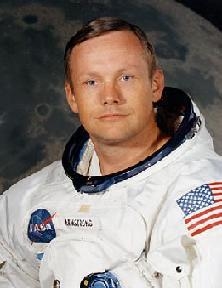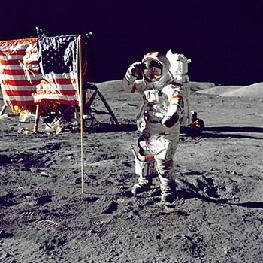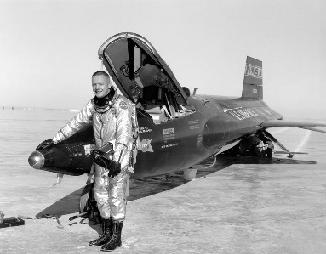 |
| (my.execpc.com/~culp/space/history.html) |
"That's one small step for man, one giant leap for mankind" (Neil Armstrong). As the first American astronaut to walk on the moon, that was how Neil Armstrong described his first movements. From 1949 to 1952, Armstrong was a naval aviator, he flew 78 combat missions during the Korean War. Armstrong was a professor of aerospace engineering at The University of Cincinnati in the 1970's. He taught and conducted research. Armstrong became an astronaut in 1962. He served as command pilot for Gemini 8 mission launched on March 16, 1966. During that mission he successfully docked two vehicles into space. In 1967 Armstrong was Commander of Apollo 11. It was the first manned lunar mission. Armstrong became the first man to land a craft on the moon, and the first man to step on its surface. In 1971 Armstrong left NASA and in 1984 Ronald Regan selected him to the National Commission on Space where he worked on developing goals for the future space programs today (Neil Armstrong Biography). Armstrong was ahead of his time by going above and beyond exploring the wonders of earth but he used his trailblazing attitude to take steps toward one of his dreams since childhood; a new world. Neil Armstrong, the first man on the moon displayed heroic acts of determination, modesty and the ability to be a trailblazer throughout his life time.
Neil Armstrong's determination was prevalent from his childhood interest. Like other young children, Armstrong was already interested in aircraft and flight, but he took it to the next level. "Airplanes drew his interest from the age of six, when he took his first airplane ride. He began taking flying lessons at age fourteen, and on his sixteenth birthday he was issued a pilot's license...He also performed experiments using the model planes he had made. Through such activities he was preparing for what would be a distinguished career in aeronautics, or the design, construction, and navigation of aircrafts. Armstrong was also interested in outer space at a young age. His fascination was fueled by a powerful telescope owned by a neighbor. Armstrong was thrilled with the views of the stars, the moon, and the planets he saw through this device" (Neil Armstrong Biography). Armstrong used his intellect to create wind turbines and advanced model airplanes at a young age while many children were unable to comprehend the experiments he conducted. While most other kids were living one day at a time, he was already building his knowledge and had already been successful in more things than many adults accomplished in a lifetime. He started flying planes before he had a license to drive a car. This showed how serious and driven to succeed he really was. He took the initiative to accomplish things at such a young age in order to later sculpt his career path in life. To pay for his flying lessons he worked many jobs day and night to earn money for his love of flying. These prior experiences fueled his interests allowing him to continue onto the path that he already treaded on, "Armstrong entered Indiana Purdue University in 1947 with a U.S. Navy scholarship. After two years of study he got called up to active duty with the Navy and won his set of pilot wings at Pensacola Naval Air Station in Florida. At twenty he was the youngest pilot in his squadron. He flew seventy eight combat missions during the Korean war...After the war Armstrong returned to Purdue and completed and degree in Aeronautical Engineering in 1955. He immediately accepted a job with the Lewis Flight Propulsion Laboratory of the National Advisory Committee for Aeronautics (NACA) in Cleveland, Ohio" (Neil Armstrong Biography). Armstrong was so strong minded after he returned from the Navy, he went back to school to complete his degree because he knew getting a good education was an important foundation for the future. He went through life as if he had a checklist of milestones he had to accomplish. With Armstrong's focused mind his successions were as expected as taking a breath. His tenacity and bravery was evident by the fact that he was so young, and at the same time the number one pilot in his squadron, showing his dedication and confidence for the job. This was also demonstrated through his flying in deadly combat missions at the young age of twenty where he earned three air medals and awards. Armstrong's determination as a child was a direct influence to his successful naval career.
 |
| (www.design-laorosa.com/2010_11_12_archive.html) |
In addition to being a hard working student, a naval pilot, and eventually a father, he was more importantly a modest man. As the first man on the moon Armstrong avoided the spotlight and preferred a close to anonymous lifestyle, "In an America that hungers for heroes he is the genuine article many times over; a brave jet fighter pilot who narrowly escaped death on one of his seventy eight combat missions in Korea; a daring test pilot who soared in the X-15, and experimental rocket plane; and the Apollo 11 Commander who deftly guided the lunar module Eagle past boulders and craters before landing on the moon with only twenty seconds of fuel to spare" (Curnutte and Bonfield). With his walk on the moon Armstrong took his place among the greatest explorers in history. He could have chosen to live the heroes lifestyle in fame, but instead choose to retreat from the spotlight and settle in southwest Ohio with his family. Because he had always been reluctant to discuss his accomplishments, many thought he was reclusive. But he was an active participant in his southwest Ohio community. He assimilated himself as a farmer, community board member and by teaching at the University of Cincinnati as a professor of aerospace engineering. He also made time for his family by spending time with his two boys at Boy Scout meetings and sporting events. Armstrong is the definition of the word humble, for example, "Armstrong was never interested in fame, it appeared he deplored it. In retrospect, the magnitude of this famous astronauts modesty matched in score the enormity of the Apollo 11 accomplishment" (Black). Armstrong's life after the moon walk had been described as his battle between obligation and modesty. He always felt obliged to reach out to other people because he knew by living his life, he touched many other lives at the same time. But modesty came out in him as he held in such high regard the thousands of people who designed each and every aspect of the Apollo 11 Saturn Rocket. He believed his role as first man did not compare to the fantastic machine he had only monitored. Neil Armstrong lived a humble and normal lifestyle after his heroic act which in turn is possibly the greatest achievement of the 20th century.
Neil Armstrong is a trailblazer for being the first man to walk on the moon. Before becoming the first man on the moon, "...Armstrong was a test pilot for the National Advisory Committee for Aeronautics, the forerunner of the National Aeronautics and Space Administration (NASA). At NACA's facility at Edwards Air Force Base in California, Armstrong flew a variety of aircraft under development. In 1960, Armstrong made his first of seven trips to the fringes of space in the X-15 rocket plane. The X-15, a sleek aircraft launched from a B52 bomber and landed on Edwards famous dry lake bed, gathered data about high speed flight and atmosphere re-entry that influenced many future designs, including the space shuttle" (Armstrong). Throughout Armstrong's life he always put himself in the position to be the first to accomplish something. As a first grader he was reading a hundred books a year and skipping grades. As a sixteen year old he obtained his pilot's license and as a twenty year old he was leader of his squadron conducting 78 missions. Now in his mid twenties he participated in cutting edge rocket trial and error tests to pave the blue print for space exploration. With the inception of the astronaut program, "...Armstrong applied for NASA's astronaut corps. He was accepted into the second group of astronauts, becoming the first civilian to be chosen. In March 1966, after serving as a backup for the Gemini-Titan 8 Mission, Armstrong made his first small flight as commander of the Gemini Titan 8...Armstrong moved on to the moon-bound Apollo program. He was instrumental in adding a system that in the event of failure of the Saturn's boosters guidance system, would allow the astronauts to fly the enormous vehicle manually" (Armstrong). Again Armstrong was on the forefront of the astronaut program as the first civilian selected. Armstrong's influence on the Apollo program was the essential spark necessary to bring together the various aspects of the program and make it successful as it is today. The pinnacle of his accomplishments was his moonwalk and what it symbolized for the country during a time period of technological hope and advancement. Since the Apollo mission many trips were made to the moon, yet the first trip will always be the most memorable. It was a great feat for space exploration and for mankind.
 |
| (www.design-laorosa.com/2010_11_12_archive.html) |
Neil Armstrong is not only a hero because he was the first man to walk on the moon, but because of the characteristics that guided him toward the path of success. Determination, modesty and a trailblazing attitude were the traits that allowed him to become the heroic person he came to be. Armstrong's determination began at a young age with his overzealous love for reading and obtaining new knowledge. Then he continued with conducting experiments with his model planes and eventually earning his pilot's license when he was only fifteen. This determination carried him to college by earning a Navy scholarship to Purdue University. It took determination to be the leader of his squadron at the age of twenty and then to return back to finish college after fighting successful missions in defense of our country. His determination consistently shaped his future success, as he did not wait for opportunities to happen instead he decided his own destiny. Armstrong showed the type of character he had in modesty and humbleness after the moon-walk. He did not require all the fanfare or acknowledgements. He did not want to take any credit for being the first man on the lunar surface instead he believed circumstance chose him and all the credit should go to the scientists and people behind the scenes. Another example of Armstrong's modesty was he declined most opportunities to profit from his fame. Armstrong is not only a trailblazer for being the first man on the moon, but he was also the first civilian man accepted into NASA's astronaut program. He was always leading the way. He experimented with prototype jets and took risks necessary to complete the mission goals which is what a true hero is made of. Armstrong always said he was just in the right place at the right time and never really took credit for his achievements, but his positive attitude and persistence helped him pave the way for the rest of us. Armstrong inspires me because he was intelligent, driven and goal oriented at such a young age. Even in his childhood he was accomplishing amazing things ahead of his time. Armstrong's love for aeronautical engineering is also inspiring to me and although war interrupted his education, he showed perseverance and returned to college to complete his degree. I like that he took chances, but for the benefit to promote and further scientific discovery. He inspires me to want to explore new worlds and to put myself out there and to succeed in life, while also continuing with my education to be in the position to be able to do something great. But, while achieving these accomplishments, he remained humble and grounded. Neil Armstrong will be forever remembered as a hero in the field of space exploration as we one day continue our journey to different planets and galaxies. Hopefully he will also be remembered for those important character traits that got him there. It was just one of those moments in time that anyone in their mid forties can tell you where they were and what they were doing when they heard the phrase "That's one small step for man, one giant leap for mankind" (Neil Armstrong).
Page created on 5/19/2011 12:00:00 AM
Last edited 5/19/2011 12:00:00 AM
